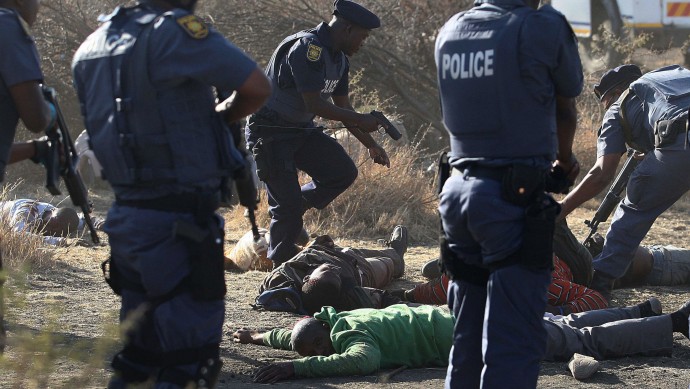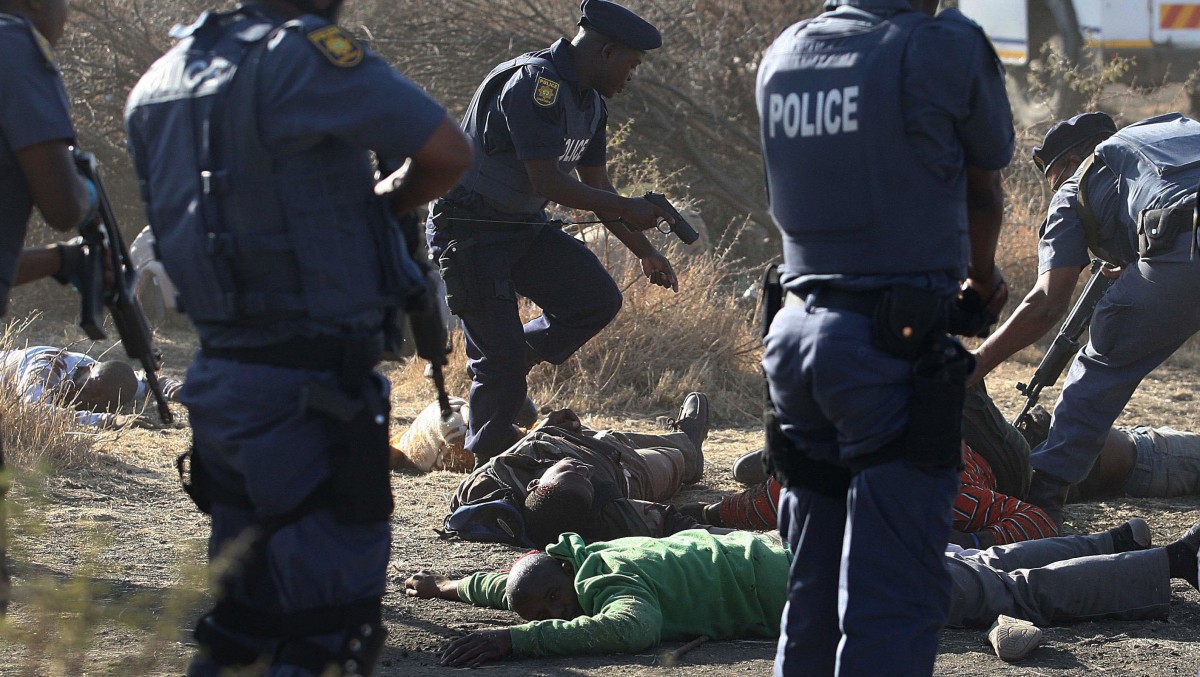
(NAMIBIA) MintPress — South African prosecutors provisionally dropped charges over the weekend after previously charging 270 platinum miners with the murder of 34 colleagues who were shot by police in the Aug. 16 shootings at the Lonmin platinum mine in Marikana, northwest of Johannesburg.
The charges, based on apartheid-era law, added to the rage and controversy surrounding the worst police violence to hit South Africa since apartheid ended, bringing to light the economic apartheid system under which mine workers still suffer.
“Final charges will be made once all investigations have been completed,” said acting national director of prosecutions Nomgcobo Jibo in a news conference on Sunday. “The murder charge against the current 270 suspects, which was provisional anyway, will be formally withdrawn provisionally in court on their next court appearance,” said Jibo.
About 100 people protested outside the court when charges were announced last week, demanding the immediate release of 270 men who have been held in custody since police clashed with striking miners allegedly carrying machetes and other weapons last month.
“The policemen who killed those people are not in custody, not even one of them. This is madness,” said former ruling ANC youth party leader Julius Malema. “The whole world saw the policemen kill those people,” said Malema, who was expelled from the ANC earlier this year following a dispute with President Jacob Zuma.
In total, 44 people, including miners and police officers, were killed over the course of the violence stemming from an illegal strike and what has been called a union “turf war” between 3,000 members of the National Union of Mineworkers (NUM) and a militant branch-off union. The ANC has been harshly criticized for its response to the crisis and strong ties to the mining companies.
Common purpose law among many left-overs from apartheid
The 270 miners were originally charged under the “common purpose” law, which was used by the white minority regime to arrest activists fighting for racial equality during apartheid.
“This is under common law, where people are charged with common purpose in a situation where there are suspects with guns or any weapons and they confront or attack the police and a shooting takes place and there are fatalities,” explained South African lawyer Jay Surju in an interview with BBC’s Focus on Africa program.
Prosecutors handling the massacre in Marikana claim that striking workers collectively confronted the police and therefore are responsible for the deadly clashes.
South African constitutional law scholar Pierre de Vos negates this clause, stating on his blog, “In the 25 years since I first studied criminal law, I have never ever heard of such a thing. The NPA seems wrongly to conflate … allegations that the miners provoked the police, on the one hand, with allegations that the miners themselves incited the police to shoot at them because they had the intention to commit suicide by getting the police to kill them.”
While charges have provisionally been dropped, the miners may still be tried under the common purpose law after final investigations have been completed.
But the “common purpose” doctrine is not the only remnant of the apartheid-era in this particular case. According to development economist Margaret Chitiga-Mabugu of the Human Sciences Research Council (HSRC), “The state of mining has not improved much since apartheid.
“The mining charter requires the companies to do more than they do but the follow-up is just not there, which is a failing of the department of mineral resources,” said Chitiga-Mabugu.
A 2012 report by the Bench Marks Foundation found “the residential conditions under which Lonmin and other mine company employees live are appalling.” In its report, Communities in the Platinum Minefields, foundation researchers observed the proliferation of shacks and informal settlements, a deterioration of formal housing infrastructure and the lack of electricity and proper sewage systems as evidence of the poor conditions that workers in Marikana face.
According to the report, residents have been reporting the issues of broken down drainage systems for five years, but are yet to see any changes made in the community. Additionally, the report states that, “The Bench Marks Foundation finds the levels of fatal accidents at Lonmin unacceptable and the fact that the number of fatalities have doubled since January 2011 is worrisome.”
The settlement where the violence emerged last month came from the Wonderkop settlement, where workers sleep in overcrowded shacks and hot-wire their own water and electricity while making a monthly income of R5,000 ($595).
A ‘racial’ divide? Economic apartheid lives on
The South African migrant labor system, developed to promote segregation, control and exploitation of Africans, was the core of the apartheid economy for more than a century.
While trade unions played an important role in overturning racial apartheid through various marches and demonstrations in the late 1900s, the economic apartheid system under which workers are bound has remained mostly intact, resulting in the continuation of impoverished, unsanitary living and working conditions in mines across the country.
As Nelson Mandela negotiated the terms of a free South Africa, an unspoken deal was made with the former ruling Nationalist Party, which shifted political power to the black majority while reserving economic powers to the white minority previously in power. During the transition out of apartheid, no property seizures were made of white assets, including businesses.
At an ANC policy conference in June, President Zuma acknowledged that economic relations remain largely unchanged in the country. “We had to be cautious about restructuring the economy [at the end of apartheid] in order to maintain economic stability and confidence at the time. Thus, the economic power relations of the apartheid era have in the main remained intact. The ownership of the economy is still primarily in the hands of white males as it has always been.”
Push for nationalization
Julius Malema, who was expelled from the ANC after a series of disagreements with Zuma, is critical of the progress the president has made to overcome economic apartheid. Speaking to the strikers in Marikana, Malema questioned why the ANC was protecting London-based Lonmin PLC, which owns the mine, rather than standing up for the striking miners.
“Phanzi, Zuma, Phanzi” (Down with Zuma, Down!), chanted Malema in front of the crowd. “These are your minerals,” he said. “You must never retreat, even in death.”
Malema’s speech is reminiscent of a renewed push for the nationalization of South Africa’s natural resources. According to Chitiga-Mabugu, who helped write the Human Sciences Research Council report State Intervention in the Minerals Sector, “Marikana has put nationalization back on the agenda.”
The government claims that it cannot afford the estimated 1 trillion rand needed to purchase the private sector; meanwhile, top ANC figures continue to profit from their investments in companies like Lonmin.
The HSRC report proposes a decisive state role in the minerals sector in order to achieve developmental goals. The report calls for better alignment and coordination between partners in government and business in order for the ANC to make the minerals sector the heart of its economic policy.
According to the Guardian, Chitiga-Mabuga believes that “South Africa could have realized maximum benefit from its mines long ago, but over the years the priorities of the players have not been aligned.”
A battle of unions
The players, to which Chitiga-Mabunga is referring, include the Communist Party, the ANC and the Congress of South African Trade Unions (COSATU), which together shape the “Tripartite Alliance” that rules in South Africa.
The three groups originally came together as a powerful force to overturn apartheid, but ties have begun to fray over the past 18 years of ANC rule. With so many interests floating around, it is difficult for the ANC to please the entire alliance, which has become evident as more militant breakaway unions begin to compete with the larger organization.
Competition over bargaining rights between two rival unions has been blamed for some of the issues that led to the massacre in Marikana. At the Lonmin mine, workers found themselves caught between the National Union of Mineworkers (NUM), COSATU’s largest affiliate founded in 1982, and the Association of Mineworkers and Construction Union, which was officially registered in 2001.
The AMCU started at Lonmin just two years ago with the approval of mining company owners. The union’s leader was allegedly expelled from the NUM in the past for divisive and anarchic agitation.
Leadership within the AMCU has been accused of promising workers a pay hike from R4,000 to R12,500 and persuading union members that using traditional medicinal plants would help them evade police bullets.
Meanwhile, the AMCU blames disgruntled NUM members for the violence at Lonmin and said the crisis could have been avoided if management had not reneged on commitments to miners. Branch-off unions like AMCU challenge the NUM, which provides a strong voter base for the ANC.
The South African Communist Party (SACP) said in a statement that it is impossible to understand the tragedy “without an appreciation of how the major platinum mining corporations have created desperate community poverty, divisive tensions and a fatalistic attitude by workers towards danger and death.”
Veteran trade union leader and founder of COSATU Jay Naidoo said in a press interview, “As a society we need to ask ourselves real questions about what this level of brutality says about our society that is still so unequal, so angry and so willing to respond violently.”
While Lonmin strikers await the results of an ANC-led investigation into the brutal massacre, thousands of miners across the country have embarked on their own strikes in the continuous battle to end economic apartheid in South Africa.


